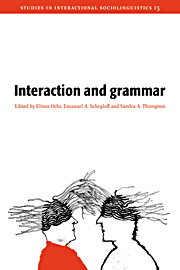Book contents
- Frontmatter
- Contents
- Notes on the contributors
- 1 Introduction
- 2 Turn organization: one intersection of grammar and interaction
- 3 Interactional units in conversation: syntactic, intonational, and pragmatic resources for the management of turns
- 4 Resources and repair: a cross-linguistic study of syntax and repair
- 5 On the “semi-permeable” character of grammatical units in conversation: conditional entry into the turn space of another speaker
- 6 On repeats and responses in Finnish conversations
- 7 “When I come down I'm in the domain state”: grammar and graphic representation in the interpretive activity of physicists
- 8 Transparent vision
- 9 Conversational signifying: grammar and indirectness among African American women
- 10 Creating evidence: making sense of written words in Bosavi
- Appendix Transcription conventions
- Index
9 - Conversational signifying: grammar and indirectness among African American women
Published online by Cambridge University Press: 14 January 2010
- Frontmatter
- Contents
- Notes on the contributors
- 1 Introduction
- 2 Turn organization: one intersection of grammar and interaction
- 3 Interactional units in conversation: syntactic, intonational, and pragmatic resources for the management of turns
- 4 Resources and repair: a cross-linguistic study of syntax and repair
- 5 On the “semi-permeable” character of grammatical units in conversation: conditional entry into the turn space of another speaker
- 6 On repeats and responses in Finnish conversations
- 7 “When I come down I'm in the domain state”: grammar and graphic representation in the interpretive activity of physicists
- 8 Transparent vision
- 9 Conversational signifying: grammar and indirectness among African American women
- 10 Creating evidence: making sense of written words in Bosavi
- Appendix Transcription conventions
- Index
Summary
Introduction
This paper examines conversational signifying, a practice fundamental to African American communication and identity. Though various forms of signifying have been previously investigated, no studies have explored how signifying is conversationally constructed through the systematic use of particular grammatical, prosodic and discursive structures to convey indirect messages. Women's interactions are the focus of this analysis not only because they have been largely ignored, but more importantly because women are often the innovators and connoisseurs of this empowering, artful practice.
Indirectness through signifying
In the following sections of the paper, the practice of signifying is introduced as part of the African American system of conversational indirectness. The discussion explores the ways in which language and interaction work together to create indirectness which in turn is a resource for mediating and realigning social relationships.
Forms of indirectness
Though African American interaction and communicative style have provided the scholarly community and public culture with numerous instances of the ways in which grammar and interaction reflect self, identity, and reality, African American language and discourse are often analyzed in terms of middle-class American language norms and practices (Kochman, 1981; Labov, 1972a). This paper views African American language and discourse as a multiconstructed and multitiered system which comprises norms of interaction which are both American and particularly African American. This system incorporates counterlanguage, especially forms of indirect discourse (cf. Morgan, 1989, 1991, 1993, 1994a).
Several analyses of African American interaction have suggested that indirectness is characteristic of, rather than one of a number of styles of African American speech.
- Type
- Chapter
- Information
- Interaction and Grammar , pp. 405 - 434Publisher: Cambridge University PressPrint publication year: 1996
- 52
- Cited by

